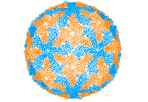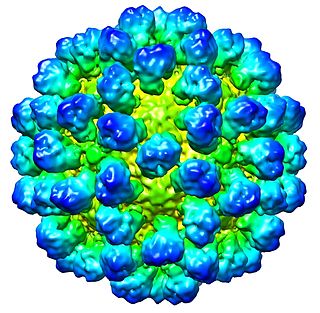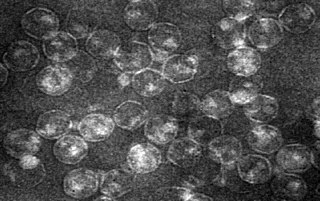
The rhinovirus is the most common viral infectious agent in humans and is the predominant cause of the common cold. Rhinovirus infection proliferates in temperatures of 33–35 °C (91–95 °F), the temperatures found in the nose. Rhinoviruses belong to the genus Enterovirus in the family Picornaviridae.

Coxsackieviruses are a few related enteroviruses that belong to the Picornaviridae family of nonenveloped, linear, positive-sense single-stranded RNA viruses, as well as its genus Enterovirus, which also includes poliovirus and echovirus. Enteroviruses are among the most common and important human pathogens, and ordinarily its members are transmitted by the fecal-oral route. Coxsackieviruses share many characteristics with poliovirus. With control of poliovirus infections in much of the world, more attention has been focused on understanding the nonpolio enteroviruses such as coxsackievirus.

Enterovirus is a genus of positive-sense single-stranded RNA viruses associated with several human and mammalian diseases. Enteroviruses are named by their transmission-route through the intestine.
Echovirus is a polyphyletic group of viruses associated with enteric disease in humans. The name is derived from "enteric cytopathic human orphan virus". These viruses were originally not associated with disease, but many have since been identified as disease-causing agents. The term "echovirus" was used in the scientific names of numerous species, but all echoviruses are now recognized as strains of various species, most of which are in the family Picornaviridae.

Orbivirus is a genus of double-stranded RNA viruses in the family Reoviridae and subfamily Sedoreovirinae. Unlike other reoviruses, orbiviruses are arboviruses. They can infect and replicate within a wide range of arthropod and vertebrate hosts. Orbiviruses are named after their characteristic doughnut-shaped capsomers.
African horse sickness (AHS) is a highly infectious and deadly disease caused by African horse sickness virus. It commonly affects horses, mules, and donkeys. It is caused by a virus of the genus Orbivirus belonging to the family Reoviridae. This disease can be caused by any of the nine serotypes of this virus. AHS is not directly contagious, but is known to be spread by insect vectors.

Avulavirinae is a subfamily of viruses in the family Paramyxoviridae. Members of the subfamily are collectively known as avulaviruses. All members of the subfamily primarily infect birds. Avulavirinae was previously recognized as the genus Avulavirus before being elevated to a subfamily. The term avula comes from "avian rubula", distinguishing it from rubulaviruses of the subfamily Rubulavirinae due to avulaviruses only infecting birds and translating protein V from an edited RNA transcript. The most notable avulavirus is the Newcastle disease virus, a strain of Avian orthoavulavirus 1.

Coltivirus is a genus of viruses that infects vertebrates and invertebrates. It includes the causative agent of Colorado tick fever. Colorado tick fever virus can cause a fever, chills, headache, photophobia, myalgia, arthralgia, and lethargy. Children, in particular, may develop a hemorrhagic disease. Leukopenia with both lymphocytes and neutrophils is very common for Colorado tick fever virus. In either case, the infection can lead to encephalitis or meningitis.

Phytoreovirus is a genus of viruses, in the family Reoviridae, in the subfamily Sedoreovirinae. They are non-turreted reoviruses that are major agricultural pathogens, particularly in Asia. Oryza sativa for RDV and RGDV, dicotyledonous for WTV, and leafhoppers serve as natural hosts. There are three species in this genus. Diseases associated with this genus include: WTV: galls (tumor). RDV: dwarf disease of rice. RGDV: dwarfing, stunting, and galls.
Vesivirus is a genus of viruses, in the family Caliciviridae. Swine, sea mammals, and felines serve as natural hosts. There are two species in this genus. Diseases associated with this genus include: respiratory disease, Feline calicivirus (FCV); conjunctivitis, and respiratory disease.

Lagovirus is a genus of viruses, in the family Caliciviridae. Lagomorphs serve as natural hosts. There are two species in this genus. Diseases associated with this genus include: necrotizing hepatitis leading to fatal hemorrhages.

Equine encephalosis virus (EEV) is a species of virus the Orbivirus genus, and a member of the Reoviridae family, related to African horse sickness virus (AHSV) and Bluetongue virus (BTV).
Capripoxvirus is a genus of viruses in the subfamily Chordopoxvirinae and the family Poxviridae. Capripoxviruses are among the most serious of all animal poxviruses. Sheep, goat, and cattle serve as natural hosts. These viruses cause negative economic consequences by damaging hides and wool and forcing the establishment of trade restrictions in response to an outbreak. The genus consists of three species: sheeppox virus (SPPV), goatpox virus (GTPV), and lumpy skin disease virus (LSDV). They share no serological relationship with camel pox, horse pox, or avian poxes. Capripoxviruses for sheeppox and goatpox infect only sheep and goat respectively. However, it is probable that North American relatives, the mountain goat and mountain sheep, may be susceptible to the strains but has not been experimentally proven. Lumpy skin disease virus affects primarily cattle, but studies have been shown that giraffes and impala are also susceptible to LSDV. Humans cannot be infected by Capripoxviruses.
Mastadenovirus is a genus of viruses, in the family Adenoviridae. Humans and other mammals serve as natural hosts. There are 51 species in this genus. The genus as a whole includes many very common causes of human infection, estimated to be responsible for 2-5% of all respiratory infections, as well as gastrointestinal and eye infections. Symptoms are usually mild.
The Abadina virus (ABAV) is a serotype of Palyam virus in the genus Orbivirus belonging to the Palyam serogroup. It was considered a distinct species of virus until 1984.
The Acado virus (ACDV) is a serotype of Corriparta virus in the genus Orbivirus in the Corriparta serogroup. Isolated from Culex antennatus and C. univittatus neavi in Ethiopia. Not reported to cause disease in humans.

Avibirnavirus is a genus of viruses in family Birnaviridae. There is a single species in this genus: Infectious bursal disease virus, which infects chickens and other fowl. It causes severe inflammation of the bursa of Fabricius, and causes considerable morbidity and mortality.
The Peruvian horse sickness virus (PHSV) is a cause of the neurological disorder Peruvian horse sickness resulting in encephalitis in horses and other livestock. The disease has significantly affected livestock in areas of Peru and has also been documented in northern Australia.
Lubombo virus (LUBV) is an orbivirus that infects vertebrates and culicine mosquitoes, thought to be its arthropod vector. It is classified in the genus Orbivirus and the family Reoviridae. It is studied at biosafety level 2.

Avian metaavulavirus 2, formerly Avian paramyxovirus 2, is a species of virus belonging to the family Paramyxoviridae and genus Metaavulavirus. The virus is a negative strand RNA virus containing a monopartite genome. Avian metaavulavirus 2 is one of nine species belonging to the genus Metaavulavirus. The most common serotype of Avulavirinae is serotype 1, the cause of Newcastle disease (ND). Avian metaavulavirus 2 has been known to cause disease, specifically mild respiratory infections in domestic poultry, including turkeys and chickens, and has many economic effects on egg production and poultry industries. The virus was first isolated from a strain in Yucaipa, California in 1956. Since then, other isolates of the virus have been isolated worldwide.










